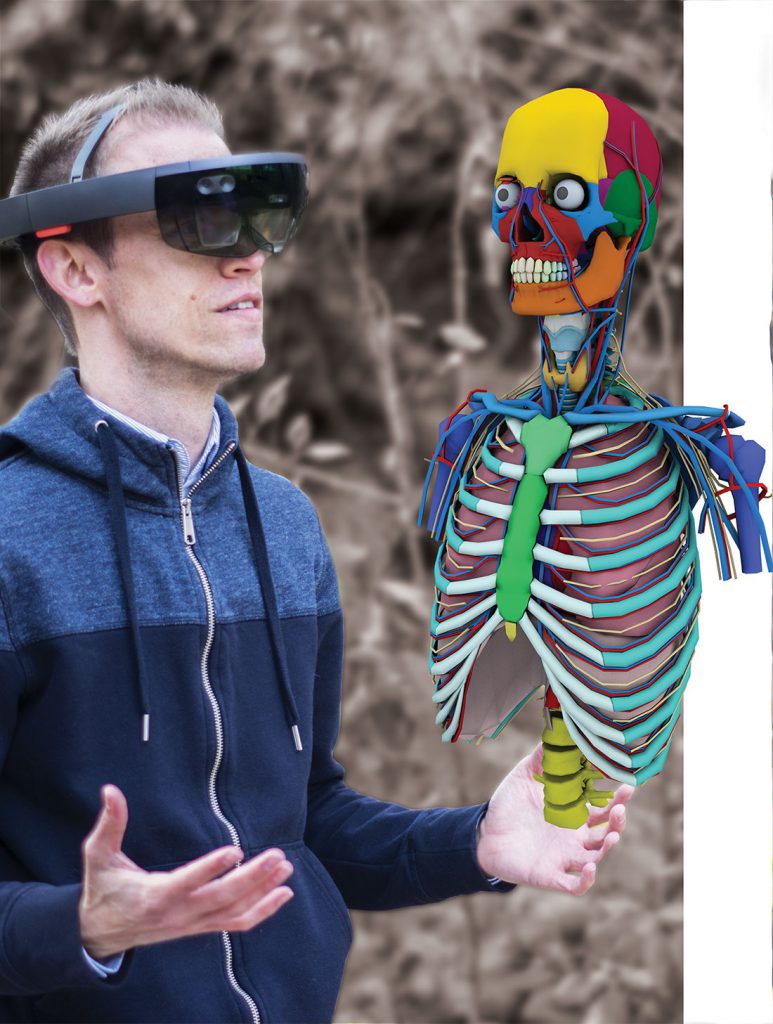
Augmented Reality
Chris Manfre wants to find a way to teach science through visuals
by Alex Boissonnas (’18)
Imagine an anatomy class where instead of staring at a textbook about the nervous system, students put on pairs of glasses and watch a 3D presentation in the room around them, where instead of examining diagrams on pages, students learned through hands-on experience with interactive virtual models.
This is the reality that Chris Manfre (’18), a 41-year-old Westminster undergraduate student, is hoping to create. “I love the idea of helping people learn through visuals, so I wanted to find a way to teach science through visuals,” Chris says. “The current way of getting science animations online feels clunky, as they are long videos you have to scrub through to find the information you want to learn. My idea is creating short Twitter-style, 3D, augmented-reality animations that are accessible by speech recognition.”
Chris Manfre began his career in his twenties as an audio engineer for concerts, but design caught his attention when he wanted to create CD covers. After working as a designer for the past decade, he was looking for something new.
Chris is creating his own custom major at Westminster, where he wants to combine design, science, and education. Calling it biomedical communication and design, he says it’s a different look at how science and art can work together.
“I’ve always loved science, but I’ve never really been that good at it. I decided a couple of years ago that I wanted to find a way to finish my degree. Right now, I feel like it’s the perfect timing for art and science to combine because of new technologies,” Chris says.
He feels that art is a broad term for subjects such as design, animation, 3D modeling, and augmented/virtual reality. “What I’m trying to focus on right now is using augmented virtual reality to help people learn science in new ways,” Chris explains.
He began to think about design differently when he was hired to create 3D illustrations and animations depicting the process of Lasik eye surgery. “That was the turning point for me, where I realized design and animation have a powerful way of connecting with people,” Chris says. “They connect with people in a way that things like a textbook can’t. We can use the power of design to help people learn science.”
Biology professor Bonnie Baxter (one of his academic advisors) says that Chris’s work helps illuminate the commonalities between art and science. “One of the things that Chris reminds us of is how similar the process of art and the process of science are,” Bonnie says. “They’re both creative processes, and they both involve experimental or creative design, so you are using a lot of the same process skills when you do art and when you do science.”
Initially, Bonnie did not know what Chris’s work entailed, but she was excited once she realized the learning potential offered through using augmented reality. “All I could think of was what a great tool it would be for students to visualize things like cellular processes that you can’t see,” Bonnie says. “You can’t even see them with a microscope, so we have to ask questions with indirect methods to know what’s going on in a cell. Putting a student inside a cell would be incredible.”
Bonnie says she thinks art is sometimes not valued enough in education, where it’s proven to be an effective form of communication. “What we know from the literature on education in high school—and even as low as elementary school—is that students who experience a barrier for learning science and math can get engaged if you incorporate art,” Bonnie explains. “Art as a vehicle to bring a student into learning is a pretty brilliant idea—and it’s well backed up. That has not been shown at the college level yet, and that’s what we’re trying to do.”
A big part of Chris’s project is to change the way people think about art. Art programs are often the target of budget cuts in education, and he thinks the time has come for that perspective to change.
“When I was growing up, I wanted to go into art, and everyone was like, ‘Well, what do you want to do with an art degree? Are you going to try to sell paintings?’” Chris says. “I feel like people need to look at it and realize it’s becoming a powerful tool that can be used in education.”
Chris believes art is a key piece of future trends in technology, where augmented reality will be incorporated into daily life, much like the smartphone. Visual communication through 3D animation is a necessary component of that world, and Chris cautioned against undervaluing art education moving forward. “As we cut our funding, are we cutting a really important tool for doctors and scientists and educators to tell the visual story of science?” Chris asks.
Looking toward the future, Chris hopes his work will help change the way people view art. For him, combining design, science, and education is just one way it can be used to enhance lives. “Let’s work together to tell the powerful and beautiful visual story of science in ways never imagined,” Chris says.
About the Westminster Review
The Westminster Review is Westminster University’s bi-annual alumni magazine that is distributed to alumni and community members. Each issue aims to keep alumni updated on campus current events and highlights the accomplishments of current students, professors, and Westminster alum.
GET THE REVIEW IN PRINT STAY IN TOUCH SUBMIT YOUR STORY IDEA READ MORE WESTMINSTER STORIES
